The Annales Mettenses (priores) or (Earlier) Annals of Metz are a set of Reichsannalen covering the period from the rise of Pepin of Heristal in Austrasia (c. 675) to the time of the writing (c. 805), surviving as part of a wider compilation including, among other texts, the full entries of the Royal Frankish Annals for the years 806–829.
The Reichsannalen are a class of annals composed anonymously in the Carolingian Empire throughout the 9th century. They first appeared under Pepin the Short in 741 and became ubiquitous at monasteries throughout the empire in the following decades. They were not official court annals, but they often bear the bias of having been written in one regnum or another.

Austrasia, Old Frankish: Oster-rike, was a territory which formed the northeastern section of the Merovingian Kingdom of the Franks during the 6th to 8th centuries. It was centred on the Meuse, Middle Rhine and the Moselle rivers, and was the original territory of the Franks, including both the so-called Salians and Rhineland Franks, which Clovis I conquered after first taking control of the bordering part of Roman Gaul, now northern France, which is sometimes described in this period as Neustria.
The Royal Frankish Annals are Latin annals composed in Carolingian Francia, recording year-by-year the state of the monarchy from 741 to 829. Their authorship is unknown, though Wilhelm von Giesebrecht suggested that Arno of Salzburg was the author of an early section of the Annales Laurissenses majores surviving in the copy at Lorsch Abbey. The Annals are believed to have been composed in successive sections by different authors, and then compiled.
The Annales were probably composed at the monastery of Chelles towards 806 under the direction of Gisela, the sister of Charlemagne. Paul Fouracre and Richard Gerberding have rejected this hypothesis on the grounds that the Annales displays a misogynistic virulence towards Plectrude, but considering her part in thwarting the succession of Charles Martel, this may be unsurprising coming from Charles Martel's granddaughter (according to Rosamond McKitterick). The purpose of the composition was probably to justify the impending divisio regnorum (division of the kingdom) among Charlemagne's sons. The Annales were concerned to justify the Carolingian ruling house and lay stress to the idea of God's plan unfolding in the Carolingian rise to power, while simultaneously denigrating the former Merovingian dynasty. They were deeply concerned with the inheritance of Charlemagne's eldest son, Charles the Younger.

Chelles Abbey was a Frankish monastery founded c. 658 during the early medieval period. It was intended initially as a monastery for women; then its reputation for great learning grew, and with the afflux of men wishing to follow the monastic life, a parallel male community was established, creating a double monastery.
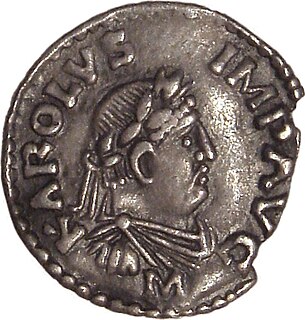
Charlemagne or Charles the Great, numbered Charles I, was king of the Franks from 768, king of the Lombards from 774, and emperor of the Romans from 800. During the Early Middle Ages, he united the majority of western and central Europe. He was the first recognised emperor to rule from western Europe since the fall of the Western Roman Empire three centuries earlier. The expanded Frankish state that Charlemagne founded is called the Carolingian Empire. He was later canonized by Antipope Paschal III.

Plectrude was the consort of Pepin of Herstal, the mayor of the palace and duke of the Franks, from about 670. She was the daughter of Hugobert, seneschal of Clovis IV, and Irmina of Oeren. She was the regent of Neustria during the minority of her grandson Theudoald from 714 until 718.
The earliest incident the Annales records is the murder of Gundoin by Pepin probably in the 670s. This story is found in no other written source and is commonly taken as legend. Gundoin supposedly murdered Pepin's father Ansegisel and then Pepin, when he was of age, tracked down and killed Gundoin, and seized power in Austrasia. According to the Annales, which is the earliest source for the Merovingian "decline", the king Theuderic III had become oppressive and unjust, thus forcing Pepin to invade his kingdom and defeat him in the great Battle of Tertry. Thereafter, we are told, Pepin held the reins of the kingdom even though he oversaw the succession of Theuderic's sons.
Ansegisel was the younger son of Saint Arnulf, bishop of Metz. He served King Sigebert III of Austrasia (634–656) as a duke and domesticus. He was killed sometime before 679, slain in a feud by his enemy Gundewin. Through his son Pepin, Ansegisel's descendants would eventually become Frankish kings and rule over the Carolingian Empire.
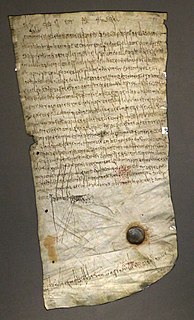
Theuderic III (c.651–691) was the king of Neustria on two occasions and king of Austrasia from 679 to his death in 691. Thus, he was the king of all the Franks from 679. The son of Clovis II and Balthild, he has been described as a puppet – a roi fainéant – of Ebroin, the Mayor of the Palace, who may have even appointed him without the support of the nobles.

The Battle of Tertry was an important engagement in Merovingian Gaul between the forces of Austrasia under Pepin II on one side and those of Neustria and Burgundy on the other. It took place in 687 at Tertry, Somme, and the battle is presented as an heroic account in the Annales mettenses priores. After achieving victory on the battlefield at Tertry, the Austrasians dictated the political future of the Neustrians.

Charles Martel was a Frankish statesman and military leader who, as Duke and Prince of the Franks and Mayor of the Palace, was the de facto ruler of Francia from 718 until his death. He was a son of the Frankish statesman Pepin of Herstal and Pepin's mistress, a noblewoman named Alpaida. Charles successfully asserted his claims to power as successor to his father as the power behind the throne in Frankish politics. Continuing and building on his father's work, he restored centralized government in Francia and began the series of military campaigns that re-established the Franks as the undisputed masters of all Gaul. According to a near-contemporary source, the Liber Historiae Francorum, Charles was "a warrior who was uncommonly [...] effective in battle". Much attention has been paid to his success in defeating an Arab raid in Aquitaine at the Battle of Tours. Alongside his military endeavours, Charles has been traditionally credited with a seminal role in the development of the Frankish system of feudalism.
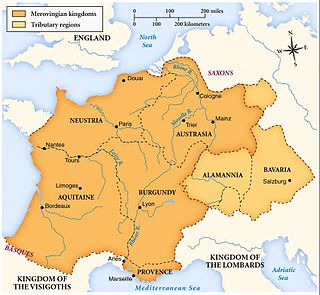
The Merovingian dynasty was the ruling family of the Franks from the middle of the 5th century until 751. They first appear as "Kings of the Franks" in the Roman army of northern Gaul. By 509 they had united all the Franks and northern Gaulish Romans under their rule. They conquered most of Gaul, defeating the Visigoths (507) and the Burgundians (534), and also extended their rule into Raetia (537). In Germania, the Alemanni, Bavarii and Saxons accepted their lordship. The Merovingian realm was the largest and most powerful of the states of western Europe following the fall of the Western Roman Empire.

Pepin II, commonly known as Pepin of Herstal, was a Frankish statesman and military leader who de facto ruled Francia as the Mayor of the Palace from 680 until his death. He took the title Duke and Prince of the Franks upon his conquest of all the Frankish realms.

Carloman was the eldest son of Charles Martel, majordomo or mayor of the palace and duke of the Franks, and his wife Chrotrud of Treves. On Charles's death (741), Carloman and his brother Pepin the Short succeeded to their father's legal positions, Carloman in Austrasia, and Pepin in Neustria. He was a member of the family later called the Carolingians and it can be argued that he was instrumental in consolidating their power at the expense of the ruling Merovingian kings of the Franks. He withdrew from public life in 747 to take up the monastic habit, "the first of a new type of saintly king," according to Norman Cantor, "more interested in religious devotion than royal power, who frequently appeared in the following three centuries and who was an indication of the growing impact of Christian piety on Germanic society".

Neustria, or Neustrasia, was the western part of the Kingdom of the Franks.
The Carolingian dynasty was a Frankish noble family founded by Charles Martel with origins in the Arnulfing and Pippinid clans of the 7th century AD. The dynasty consolidated its power in the 8th century, eventually making the offices of mayor of the palace and dux et princeps Francorum hereditary, and becoming the de facto rulers of the Franks as the real powers behind the Merovingian throne. In 751 the Merovingian dynasty which had ruled the Germanic Franks was overthrown with the consent of the Papacy and the aristocracy, and a Carolingian Pepin the Short was crowned King of the Franks. The Carolingian dynasty reached its peak in 800 with the crowning of Charlemagne as the first Emperor of Romans in the West in over three centuries. His death in 814 began an extended period of fragmentation of the Carolingian Empire and decline that would eventually lead to the evolution of the Kingdom of France and the Holy Roman Empire.

Childeric III was King of Francia from 743 until he was deposed by Pope Zachary in March 751 at the instigation of Pepin the Short. Although his parentage is uncertain, he is considered the last Frankish king from the Merovingian dynasty. Once Childeric was deposed, Pepin the Short, who was the father of emperor Charlemagne, was crowned the first king of the Franks from the Carolingian dynasty.
Under the Merovingian dynasty, the mayor of the palace or majordomo was the manager of the household of the Frankish king. The office existed from the sixth century, and during the seventh it evolved into the "power behind the throne" in the northeastern kingdom of Austrasia. In 751, the mayor of the palace, Pepin the Short, orchestrated the deposition of the king, Childeric III, and was crowned in his place.

Saint Arnulf of Metz was a Frankish bishop of Metz and advisor to the Merovingian court of Austrasia, who retired to the Abbey of Remiremont. In French he is also known as Arnoul or Arnoulf. In English he is known as Arnold. He is claimed to be a direct descendant of Flavius Afranius Syagrius, being a case for descent from antiquity.
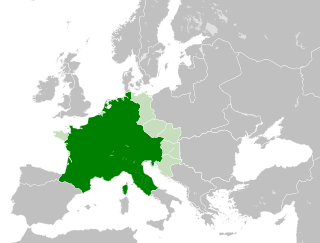
Francia, also called the Kingdom of the Franks, or Frankish Empire, was the largest post-Roman barbarian kingdom in Western Europe. It was ruled by the Franks during Late Antiquity and the Early Middle Ages. It is the predecessor of the modern states of France and Germany. After the Treaty of Verdun in 843, West Francia became the predecessor of France, and East Francia became that of Germany. Francia was among the last surviving Germanic kingdoms from the Migration Period era before its partition in 843.
The Pippinids or Arnulfings were a Frankish aristocratic family from Austrasia during the Merovingian period. They dominated the office of mayor of the palace after 687 and eventually supplanted the Merovingians in 751, founding the Carolingian dynasty.
Liber Historiae Francorum is a chronicle written anonymously during the 8th century. The first sections served as a secondary source for early Franks in the time of Marcomer, giving a short breviarum of events until the time of the late Merovingians. The subsequent sections of the chronicle are important primary sources for the contemporaneous history. They provide an account of the Pippinid family in Austrasia before they became the most famous Carolingians.

Clovis III was the Frankish king of Austrasia in 675 and possibly into 676. A member of the Merovingian dynasty, he was a child and his reign so brief and contested that he may be considered only a pretender. He is sometimes even left unnumbered and Clovis IV is instead called Clovis III. The only source for his reign is the contemporary Suffering of Leudegar.
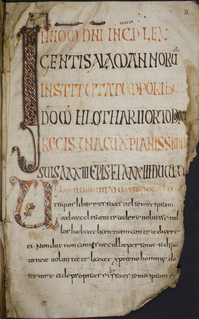
Chlothar IV was the king of Austrasia from 717 until his death. He was a member of the Merovingian dynasty, and was installed by Charles Martel, a candidate for the office of mayor of the palace, in opposition to Chilperic II, whose realm was thus reduced to Neustria. This marks the first time since 679 that the kingdom of the Franks was divided. Following Chlothar's death, it was reunited under Chilperic.
Drogo was a Frankish nobleman, the eldest son of Pippin of Heristal and Plectrudis. He was the duke of Champagne from the early 690s.
The Duchy of Alsace was a large political subdivision of the Frankish Empire during the last century and a half of Merovingian rule. It corresponded to the territory of Alsace and was carved out of southern Austrasia in the last decade of the reign of Dagobert I, probably to stabilise the southern reaches of Austrasia against Alemannia and Burgundy. By the late Middle Ages, the region was considered part of Swabia.















